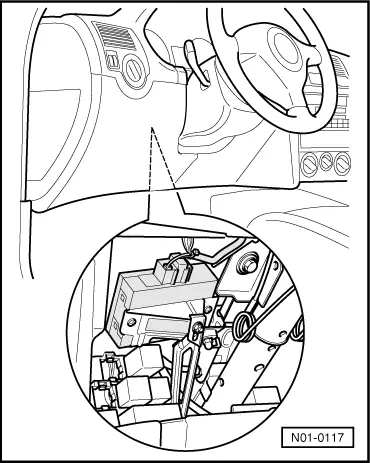Golf Mk4
|
Self-diagnosis for central locking
Functional description
The locking units located in the doors (door lock) have an electric motor. The motor locks the door and also takes care of the "Safe" condition, i.e. after locking at an external lock (door lock, tailgate, radio remote control) the vehicle is protected against theft and can no longer be unlocked from the interior. The feedback on the respective condition in control unit occurs via the contact switch in the locking unit. All the known convenience functions can be performed with the electric convenience system, interior lights control, ATA with interior monitoring and the radio remote control. If the airbag control unit is triggered, a signal is sent to the convenience control unit to unlock the doors. |
 |
|
|
→ The central locking control unit (J379) is located under the dash panel and is secured by a bracket to the steering column. It is equipped with a fault memory. The self-diagnosis connection is located in the centre console extension. The control unit detects faults in the central locking system and stores them in a permanent memory. To commence fault finding, initiate self-diagnosis and retrieve the stored information with the fault reader V.A.G 1551. System tester V.A.G 1552 may also be used. The fault information displayed is used to refer to a fault table with notes on the possible causes for directed repair measures. Faults which can be attributed to a temporary open circuit in the wiring or a loose contact, will also be stored. These faults will be displayed as sporadic faults "SP". Determining the items which have possibly triggered the anti-theft alarm system The breakdown of the display content illustrated on Page 01-284 for the display group number 10 gives information as to which component triggered the alarm system last, and can therefore help the fault finding/rectification. This "fault memory" cannot be erased. Only statistical faults are considered:
Note: Before changing a component erase fault memory, perform functional checks and interrogate fault memory again. |
